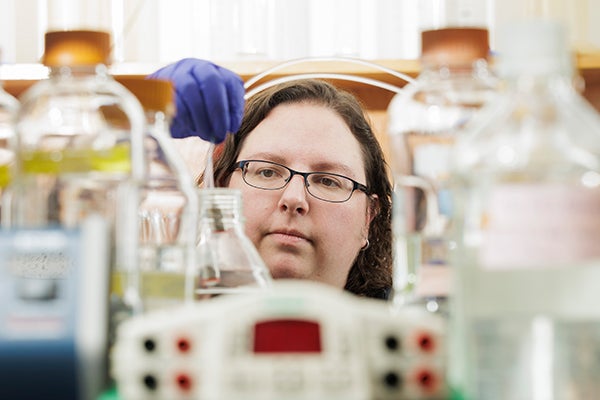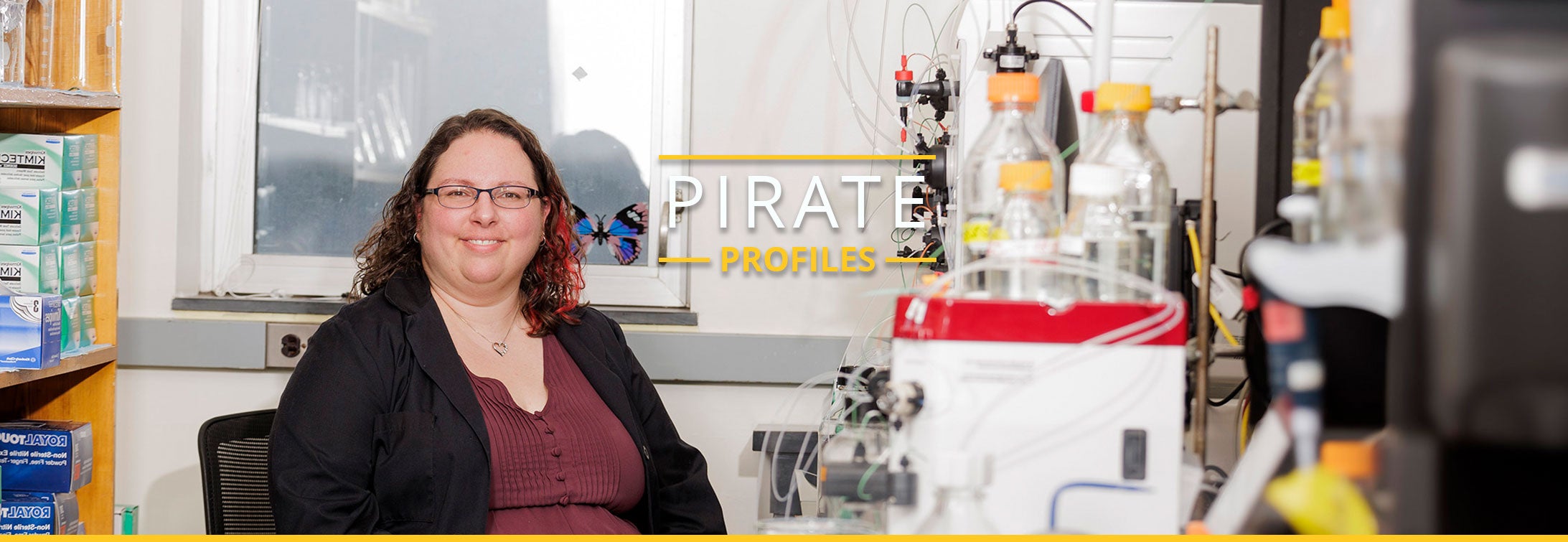Faculty: Dr. Morgan Milton
As the temperatures rise, Dr. Morgan Milton’s research on Vibrio bacteria highlights the growing risks and why we should remain vigilant during the warmer months.
At East Carolina University’s Brody School of Medicine, Milton, an assistant professor, focuses on studying bacteria that live in coastal waters and pose a threat to shellfish.
“We’re interested in studying marine-specific Vibrio that live in brackish water and coastal ecosystems, such as North Carolina estuaries where the salt concentrations are higher than the normal freshwater rivers,” she said. “That’s where these bacteria are thriving.”
Vibrio, a type of bacteria that inhabits these warmer waters, can lead to serious health risks through food poisoning and wound infection.
However, before Vibrio can even reach an oyster, they must first create biofilms to survive.

Dr. Morgan Milton experiments in her lab.
What Are Biofilms?
“Biofilms are how bacteria predominantly live in the environment,” said Milton. “It’s a colony. It’s a community of bacteria that have produced this very sticky, thick kind of goo around them that protects them from the environment. If there’s a big salt change or pH change, the biofilm helps protect them.”
“With this marine-specific bacteria we’re looking at, they’re very good at making biofilms, and the ones that are pathogenic are harmful to people and fish and marine life,” she said.
Through understanding the mechanisms of these biofilms, Milton aims to explore how they develop into harmful forms.
“We’re really interested in how bacteria make these biofilms because they have such a big medical importance. We want to understand how they’re making these biofilms at both a cellular level and a molecular level. One, how are the cells being told to make a biofilm rather than being free-swimming bacteria and, two, how within the cells are they producing the proteins that control this process?”
Milton’s hope is that the information found at this molecular level can eventually be applied to humans and, in this case, drug therapies.
“Bacterial biofilms are everywhere and they are highly resistant to antibiotics,” she said. “A lot of the antibiotics we have are designed to kill bacteria that are in a free-swimming state — kind of on their own without a community. If the antibiotics can’t get in to kill the bacteria, you’re going to have a major infection on your hands.”
Milton is dedicated to raising awareness about Vibrio bacteria to help people quickly test for it.
Today, she has partnered with the head of microbiology, Dr. John Markantonis, to test local pathogenic Vibrio bacteria samples from North Carolina residents who were infected and came to ECU Health for medical treatment.
“He has these bacteria that people were infected with that he is able to give to us to test even further,” she said. “We’ll be able to see the bacteria that impacted our community because of our location. If I was anywhere else, I would not have access to samples like that.”
For Milton, the discovery aspect is what she loves most about her research. In fact, it was this passion that led her to choose her career path.
“I loved trying to understand things we couldn’t see,” she said. “These Vibrio bacteria are about a micron long — they’re super tiny. You need a high-powered microscope to be able to see them. But that single-celled organism can do all this cool stuff as a single cell, but if you get a couple of them together, they could destroy anything in their path.”
It was Dr. John Cavanagh’s mentorship that led Milton to pursue her research with Vibrio proteins.
“I ended up joining his lab at N.C. State University in 2016 as a post-doctorate scholar and I was able to follow him to ECU to continue my research,” she said. “He was doing the type of work I wanted to do with the techniques I wanted to learn, and he has allowed me to make it my own.”
It’s no surprise that being in eastern North Carolina, with its proximity to coastal waterways, has benefited Milton and her research.
“ECU, for the type of research I am doing, is so perfectly positioned,” she said. “I think I am at the right place at the right time to, if not make a direct difference, establish initiatives that will help the community and train students to go out and be advocates.”
Milton has been at ECU for five years, becoming a faculty member in 2022, but admits it’s the strong collaborations she has made with colleagues over the last year that has accelerated her research.
“I have made connections within the Vibrio bacteria community, and made particularly strong connections with Vibrio-squid and the zebrafish communities here at ECU and at Chapel Hill, as well as UNCW.”
When she’s not working on research in her lab, she is teaching a biochemistry course for graduate students and continuing to develop her science communication class — focusing on how to effectively describe and communicate the lab work that is being conducted.
She also enjoys mentoring students to further inspire them with the type of research they hope to conduct.
“Students at ECU are humble,” she said. “They are very clever, and they are so engaged with the research and driven by passion. They want to learn and explore and give back to their community.”
“I think serving students like that is something I want to embrace, and I want to be able to give them the best opportunity to work in a research lab and get experiences that are going to set them up for success in the future.”
FAST FACTS
Hometown: Marietta, Georgia
Colleges attended and degrees:
Georgia Institute of Technology; BS, biology
Georgia Institute of Technology; MS, biology
Iowa State University; Ph.D., biochemistry
PIRATE PRIDE
Years working at ECU: Six years (three as a postdoctoral scholar, one as a research assistant professor, and two as an assistant professor)
What I do at ECU: Run a research lab, mentor students in the lab and teach graduate level classes in biochemistry at the Brody School of Medicine
What I love about ECU:
The opportunity to form diverse collaborations with people across departments and colleges, and the ability to work with students in the research lab. I love helping students develop their critical-thinking and problem-solving skills. Sharing the joy of discovery and the fascinating world of proteins and macromolecules with students is my favorite part of being a professor.
Research interests: My research is focused on understanding the molecular mechanism controlling how bacteria adapt to environmental changes. We use the bacteria Vibrio fischeri to answer questions about how bacteria form biofilms. This work will answer many basic science questions about biofilm regulatory mechanisms and will allow us to identify potential intervention points for drug targets.
What advice do you give to students? In the research lab, we are often exploring things that no one has studied before. This means we run into a lot of challenges in the lab. I tell my students that science is hard, and to try not to take it personally when an experiment doesn’t work. We regroup and try again or try something different.
QUICK QUIZ
What do you like to do when not working? I dabble in a lot of arts and crafts. My favorites are calligraphy, watercolor and gilding. Recently, I picked up embroidery and am teaching myself how to do gold work. I also enjoy reading, baking and playing video games
